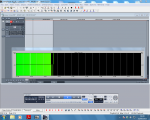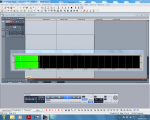Okay, maybe this will put the thread to rest, I will have the definitive answer that I seek, and this noob will go away until my next dumb question

- edit - I'm happy to help; it is just that in this topic area I've got a lot to learn. I am not participating solely to tap brains - I would help out or contribute any time, if I had a valid thought to put forward. anyhow..
I am not a 'cover band' sort of guy, but I have recorded a snippet of a 'cover song' here, to provide something solid to analyze - if anyone cares to. Remember, you are defending the modern holy grail of 'external audio interfaces' here; and their manufacturers await, with baited breath...
This is 2-track recording with guitar on the right, vox on the left. Vocal mic is an MXL 990. Guitar is an Ibanez cutaway acoustic with an Ibanez/Fishman SST pickup turned down as far as possible, running wired/XLR balanced into the PMP4000. Preamp gains on the berry are all down. EQ's are flat. I am sending to two montor send outs on the PMP4000, out those to the Mac Mini. You can hear the PMP4000 fans running in the background. Incidentally I don't like the tone of this pickup signal of the Ibanez even with fresh batteries but, whatever, my son is using my only other mic (this is home recording). Also paradoxically, I'm told by open mic people that the 1/4" out of this guitar sounds amazing. Not feeling it myself.
Obviously for purposes of this test recording I haven't applied NR or effects of any kind (far as I know). Levels for L & R were arbitrary (this isn't about seeking the perfect mix). The PMP4000 feeds the Mac Mini's line in, and I recorded this using Adobe Audition CS6, at 32 bit floating, 48K - arguably the highest resolution ever necessary for this sort of thing. I confess to having tried 96K, but I got dropped samples so backed off.
The questions -
What are the specs of this recording, what is the noise floor! ? Can anyone help to determine that?
IS IT EVEN 24 bit? IS it 24 bit depth with the 32 bit floating asides? Is the recorded file actually 48K samples/second? IS IT WHAT I THINK THAT IT IS?
In short, did my system do good work, or will an external audio interface, notably enhance my recordings?
Bonus point for identifying the original artist of the song snippet.
I can't think of anything else to factor in - but I'll answer any questions, and I greatly appreciate any help that you all might provide. I'm just a home recording guy wanting to better understand what's *really* going on relative to my deck vs. adding an ext. audio interface THank you, - Jonny D.
The file:
https://app.box.com/s/wocrxx8lkd8sn6k6a8mp7ms07wiogm8l
A screen shot of the file in progress:
View attachment 93189




 I've got 8 ports on the back of my PC and 2 on the front.
I've got 8 ports on the back of my PC and 2 on the front.